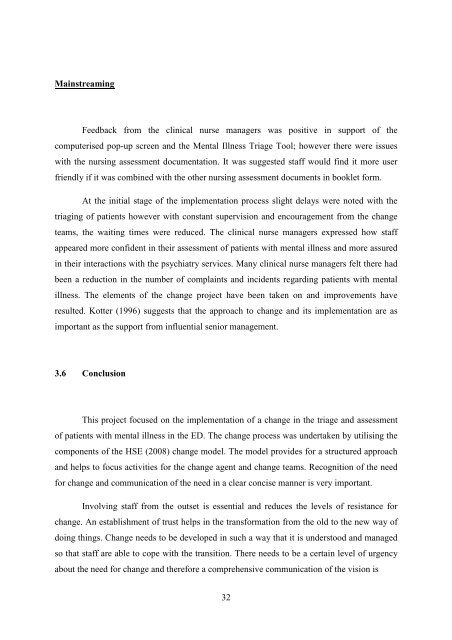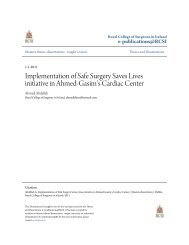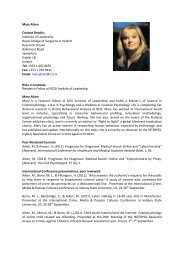Improving the Assessment and Triage of Patients with Mental Illness ...
Improving the Assessment and Triage of Patients with Mental Illness ...
Improving the Assessment and Triage of Patients with Mental Illness ...
You also want an ePaper? Increase the reach of your titles
YUMPU automatically turns print PDFs into web optimized ePapers that Google loves.
Mainstreaming<br />
Feedback from <strong>the</strong> clinical nurse managers was positive in support <strong>of</strong> <strong>the</strong><br />
computerised pop-up screen <strong>and</strong> <strong>the</strong> <strong>Mental</strong> <strong>Illness</strong> <strong>Triage</strong> Tool; however <strong>the</strong>re were issues<br />
<strong>with</strong> <strong>the</strong> nursing assessment documentation. It was suggested staff would find it more user<br />
friendly if it was combined <strong>with</strong> <strong>the</strong> o<strong>the</strong>r nursing assessment documents in booklet form.<br />
At <strong>the</strong> initial stage <strong>of</strong> <strong>the</strong> implementation process slight delays were noted <strong>with</strong> <strong>the</strong><br />
triaging <strong>of</strong> patients however <strong>with</strong> constant supervision <strong>and</strong> encouragement from <strong>the</strong> change<br />
teams, <strong>the</strong> waiting times were reduced. The clinical nurse managers expressed how staff<br />
appeared more confident in <strong>the</strong>ir assessment <strong>of</strong> patients <strong>with</strong> mental illness <strong>and</strong> more assured<br />
in <strong>the</strong>ir interactions <strong>with</strong> <strong>the</strong> psychiatry services. Many clinical nurse managers felt <strong>the</strong>re had<br />
been a reduction in <strong>the</strong> number <strong>of</strong> complaints <strong>and</strong> incidents regarding patients <strong>with</strong> mental<br />
illness. The elements <strong>of</strong> <strong>the</strong> change project have been taken on <strong>and</strong> improvements have<br />
resulted. Kotter (1996) suggests that <strong>the</strong> approach to change <strong>and</strong> its implementation are as<br />
important as <strong>the</strong> support from influential senior management.<br />
3.6 Conclusion<br />
This project focused on <strong>the</strong> implementation <strong>of</strong> a change in <strong>the</strong> triage <strong>and</strong> assessment<br />
<strong>of</strong> patients <strong>with</strong> mental illness in <strong>the</strong> ED. The change process was undertaken by utilising <strong>the</strong><br />
components <strong>of</strong> <strong>the</strong> HSE (2008) change model. The model provides for a structured approach<br />
<strong>and</strong> helps to focus activities for <strong>the</strong> change agent <strong>and</strong> change teams. Recognition <strong>of</strong> <strong>the</strong> need<br />
for change <strong>and</strong> communication <strong>of</strong> <strong>the</strong> need in a clear concise manner is very important.<br />
Involving staff from <strong>the</strong> outset is essential <strong>and</strong> reduces <strong>the</strong> levels <strong>of</strong> resistance for<br />
change. An establishment <strong>of</strong> trust helps in <strong>the</strong> transformation from <strong>the</strong> old to <strong>the</strong> new way <strong>of</strong><br />
doing things. Change needs to be developed in such a way that it is understood <strong>and</strong> managed<br />
so that staff are able to cope <strong>with</strong> <strong>the</strong> transition. There needs to be a certain level <strong>of</strong> urgency<br />
about <strong>the</strong> need for change <strong>and</strong> <strong>the</strong>refore a comprehensive communication <strong>of</strong> <strong>the</strong> vision is<br />
32
















